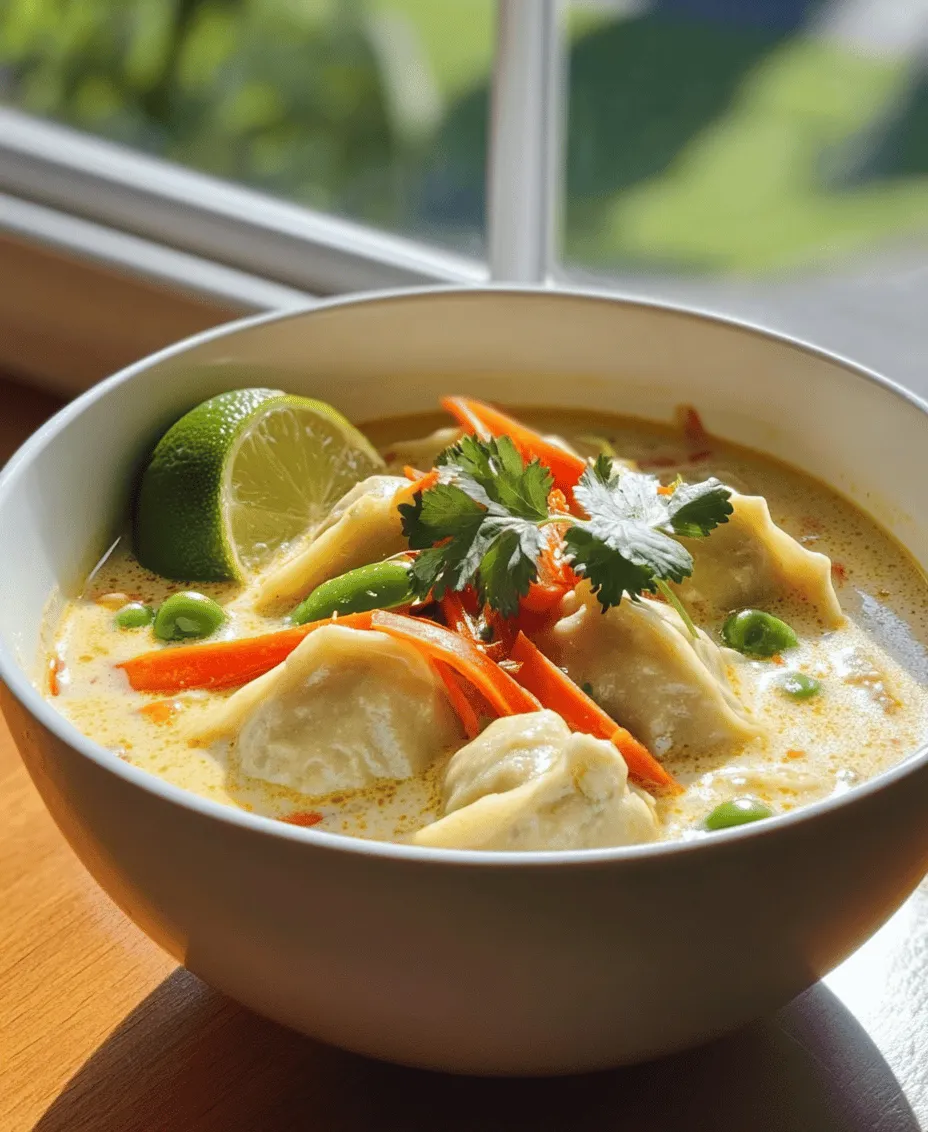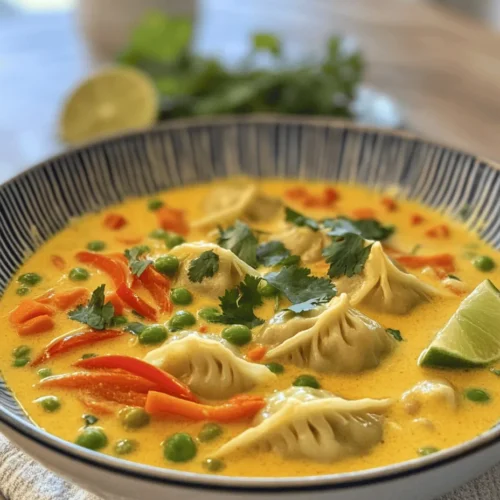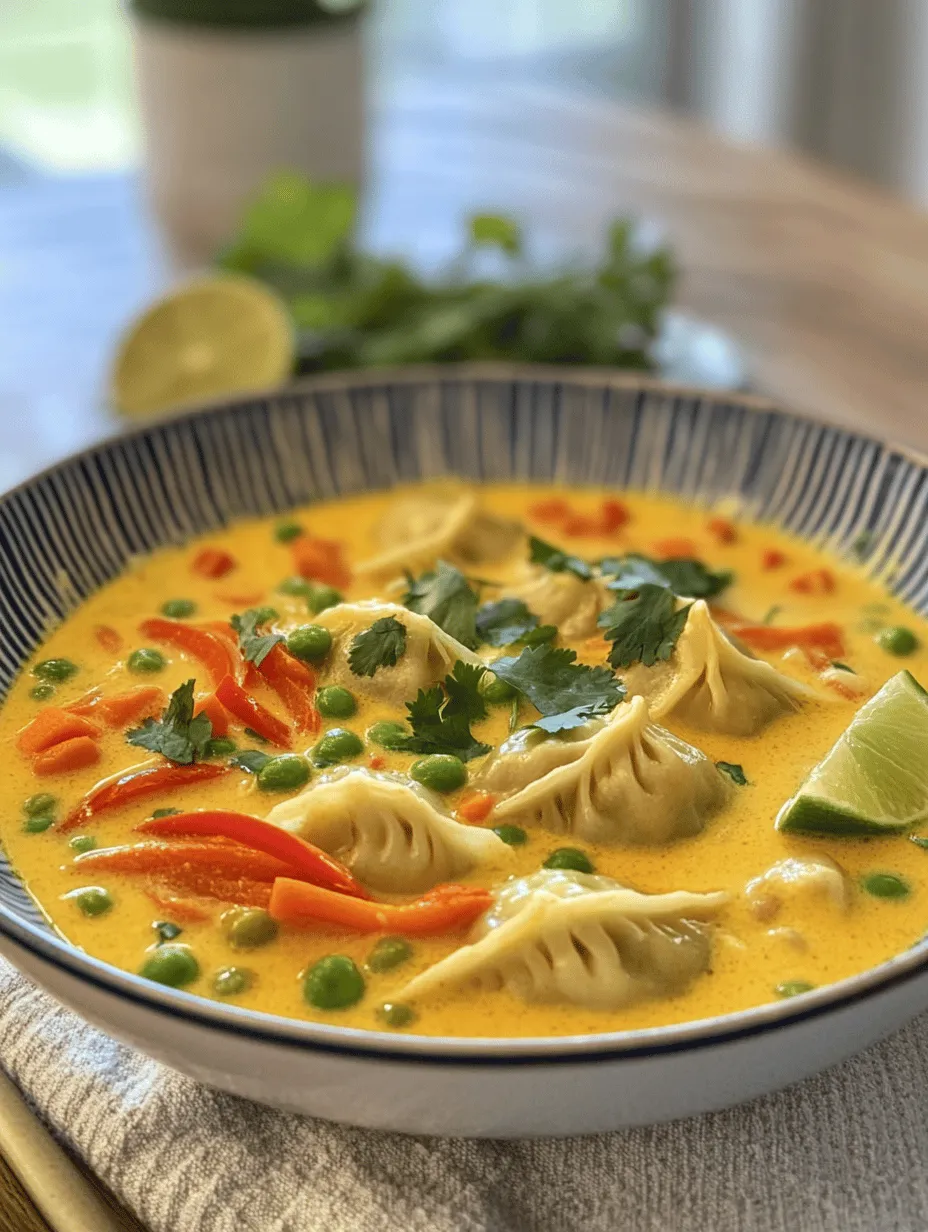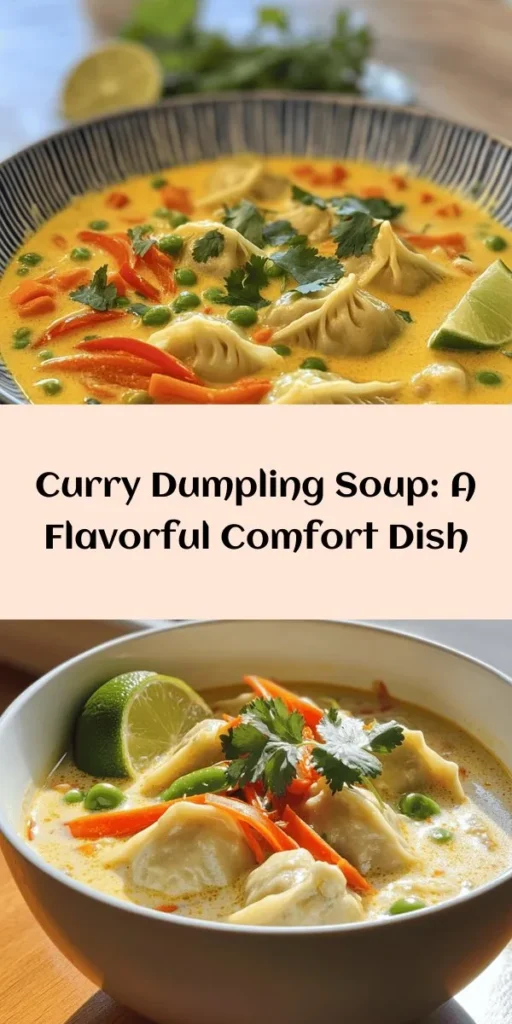Introduction
In the vast world of culinary delights, few dishes evoke the same sense of warmth and comfort as a hearty bowl of curry dumpling soup. This delightful dish, brimming with aromatic spices and tender dumplings, has become a beloved staple in many households, transcending borders and cultures. The combination of rich flavors and comforting textures makes curry dumpling soup not just a meal but an experience. Whether you’re seeking solace on a chilly evening or wanting to impress guests with a unique dish, this recipe promises to deliver satisfaction in every spoonful.
Dumpling soup holds a special place in various cuisines, from the delicate wontons of Chinese cuisine to the robust pierogi of Eastern Europe. Each culture has embraced the dumpling, making it an integral part of their culinary identity. The versatility of dumplings allows them to be filled with an array of ingredients, making them suitable for various dietary preferences and flavor profiles. In this article, we will explore the heart of this comforting dish, delve into the art of crafting perfect dumplings, and ultimately guide you to create a delicious curry dumpling soup that will warm the soul and tantalize the taste buds.
The Heart of the Dish: Understanding Dumplings
Dumplings have a rich history that dates back thousands of years and can be found in numerous forms across the globe. From Chinese jiaozi, which are often filled with pork and vegetables, to the Italian ravioli, stuffed with cheese or meat, dumplings represent a universal comfort food that has been cherished by generations. Their appeal lies in their ability to encapsulate a variety of flavors and textures within a tender dough, making them a favorite across different cultures.
Nutritionally, homemade dumplings can be a wholesome addition to your diet. When prepared with fresh ingredients and wholesome fillings, they can provide a balanced meal that includes carbohydrates, protein, and essential vitamins. The dough typically consists of flour and water, while the filling can be customized to include vegetables, meats, or plant-based proteins. This versatility allows you to create a dish that caters to your dietary needs and preferences.
The texture and flavor of dumplings are crucial to the overall experience of the dish. A well-made dumpling should have a soft, chewy exterior that holds its shape while being tender enough to give way to the flavorful filling. Achieving this perfect balance requires careful attention to the dough preparation and the selection of filling ingredients.
Crafting the Perfect Dumpling
Creating the perfect dumpling begins with understanding the essential ingredients required for the dough. The primary component is all-purpose flour, which provides the necessary structure and chewiness. This type of flour is versatile and readily available, making it an ideal choice for dumpling preparation.
Ingredients for Dumpling Dough
– All-Purpose Flour: This is the foundation of your dumpling dough. It contains gluten, which provides elasticity, allowing the dough to stretch without tearing.
– Salt: A vital ingredient in the dough, salt enhances the flavor and strengthens the gluten structure, resulting in a more resilient dough.
– Water: The temperature of the water plays a crucial role in dough preparation. Using boiling water helps to gelatinize the starches in the flour, yielding a softer and more pliable dough.
Step-by-Step Guide to Making Dumpling Dough
1. Combine the Ingredients: In a large mixing bowl, combine the all-purpose flour and salt. Mix well to ensure even distribution of salt throughout the flour.
2. Add Boiling Water: Carefully pour boiling water into the flour mixture. Using chopsticks or a fork, stir the mixture quickly to combine the flour with the water. The heat from the water will begin to cook the flour, creating a cohesive dough.
3. Knead the Dough: Once the dough is cool enough to handle, transfer it to a lightly floured surface. Knead the dough for about 8-10 minutes until it becomes smooth and elastic. This step is crucial, as proper kneading develops the gluten, resulting in the desired texture.
4. Rest the Dough: After kneading, wrap the dough in plastic wrap or cover it with a damp cloth. Allow it to rest for at least 30 minutes. Resting helps relax the gluten, making it easier to roll out the dough without it springing back.
The Importance of Using Boiling Water
Using boiling water in the dough-making process is a key technique that sets this dumpling recipe apart. The hot water helps to partially cook the flour, resulting in a dough that is softer and more pliable. This technique is particularly beneficial when making dumplings that will be boiled or steamed, as it ensures that the dumplings hold their shape and have a tender bite.
Kneading Techniques for a Smooth Texture
When kneading the dough, it’s important to use the palm of your hands to push and fold the dough. Be sure to incorporate any dry bits that may remain on the surface. A well-kneaded dough should feel smooth and elastic; if it’s sticky, you can sprinkle a little more flour as needed. Remember to keep your work surface lightly floured to prevent sticking.
Creating the Flavorful Filling
The filling is where the magic happens in dumpling preparation. A well-balanced filling can elevate your dumplings from good to extraordinary. Fresh ingredients play a vital role in enhancing the flavor profile of your dumplings. For our curry dumpling soup, we’ll be using a savory mixture that includes scallions, tofu, soy sauce, sesame oil, ginger, garlic, and black pepper.
Ingredients for the Filling
– Scallions: These add a mild onion flavor and a touch of freshness to the filling.
– Tofu: A great source of plant-based protein, tofu absorbs the flavors of the other ingredients and provides a satisfying texture. For this recipe, use firm tofu, which holds its shape well during cooking.
– Soy Sauce: This ingredient adds depth and umami to the filling, enhancing the overall taste.
– Sesame Oil: A little goes a long way—sesame oil contributes a rich, nutty flavor that complements the other ingredients beautifully.
– Ginger and Garlic: These aromatic ingredients infuse the filling with warmth and complexity.
– Black Pepper: For a hint of spice, black pepper rounds out the flavor profile of the filling.
Tips for Achieving the Right Balance of Taste and Texture
When preparing the filling, it’s important to balance flavors and textures. Start by finely chopping the scallions and mincing the ginger and garlic. Crumble the tofu into small pieces and combine all the ingredients in a mixing bowl. Taste the filling before assembling the dumplings to adjust seasoning as needed. You can add more soy sauce or sesame oil based on your preference for saltiness or richness.
Additionally, consider the texture of the filling. A good dumpling filling should have a combination of creaminess from the tofu and a slight crunch from the scallions. Mixing in a bit of cornstarch can help bind the filling and prevent it from becoming too watery during cooking.
Shaping Dumplings: A Culinary Art
Once your dumpling dough and filling are prepared, it’s time to shape the dumplings. This step is where creativity meets technique, and there are several methods to achieve the perfect dumpling shape.
Techniques for Rolling and Shaping Dumplings
1. Roll Out the Dough: After the dough has rested, divide it into smaller portions for easier handling. On a lightly floured surface, roll out each portion into a thin circle, about 3 inches in diameter. Aim for even thickness to ensure uniform cooking.
2. Fill the Dumplings: Place a small spoonful of filling in the center of each circle. Be careful not to overfill, as this can cause the dumplings to burst during cooking.
3. Seal the Dumplings: Fold the dough over the filling to create a half-moon shape. Pinch the edges together firmly to seal, ensuring no filling escapes during cooking. For added security, you can crimp the edges with a fork or create pleats with your fingers for a decorative touch.
4. Visual Cues for Perfecting the Shape: As you shape the dumplings, look for smooth edges and a rounded appearance. Practice will help you develop your technique, and soon you’ll be able to shape dumplings with ease.
5. Prevent Leaks During Cooking: Ensure that the dumplings are sealed well to prevent leaks. A little water can be applied to the edges of the dough before sealing to help them stick together better.
By mastering these techniques, you’ll create beautiful, uniform dumplings that are ready to be cooked in your flavorful curry soup.
In the next part of this article, we will delve deeper into the creation of the curry broth, the cooking methods for your dumplings, and how to assemble the perfect bowl of curry dumpling soup. Stay tuned for a culinary adventure that will elevate your home cooking and impress your family and friends.

The Soul of the Soup: Crafting the Curry Broth
The foundation of any great soup lies in its broth, and the Curry Dumpling Soup is no exception. This vibrant and fragrant curry broth is what breathes life into the dumplings, melding flavors together and creating a dish that warms both body and soul.
Overview of the Soup’s Base Ingredients
To create a rich and flavorful curry broth, you’ll need a combination of aromatic ingredients. The primary components include:
– Coconut oil: For sautéing and adding depth to the flavor.
– Coconut milk: Provides creaminess and a slightly sweet flavor that balances the spices.
– Curry paste: The heart of the broth, offering an array of spices and heat.
– Vegetable or chicken broth: The liquid base that carries all the flavors.
– Aromatics: Onions, garlic, ginger, and chilies to build the flavor profile.
Health Benefits of Coconut Oil and Coconut Milk in Soups
Coconut oil is celebrated for its high medium-chain triglycerides (MCTs), which can provide quick energy and may support metabolism. It also contains lauric acid, known for its antimicrobial properties. On the other hand, coconut milk is rich in vitamins C, E, and several B vitamins, offering hydration and a creamy texture without dairy. This makes the broth not only delicious but also nutritious.
Explanation of Curry Paste: Types and Flavor Profiles
Curry paste is essential for infusing the soup with flavor. Various types of curry pastes are available, including:
– Red curry paste: Made from red chilies, it provides a rich, spicy flavor.
– Green curry paste: Contains green chilies and fresh herbs, giving it a bright, herbal taste.
– Yellow curry paste: Milder and sweeter, it features turmeric and is perfect for those who prefer a less spicy option.
Each type brings its unique flavor profile, so choose one based on your heat preference and the flavors you wish to highlight in your soup.
Step-by-Step Guide to Preparing the Soup Base
1. Heat the Coconut Oil: In a large pot, heat 2 tablespoons of coconut oil over medium heat. This oil will serve as the base for your aromatic ingredients.
2. Sauté Aromatics: Add 1 chopped onion, 3 minced garlic cloves, and a thumb-sized piece of grated ginger to the pot. Sauté until the mixture becomes fragrant and the onions turn translucent, about 5 minutes.
3. Incorporate the Curry Paste: Stir in 2 to 3 tablespoons of your chosen curry paste. Cook for another 2-3 minutes, allowing the paste to bloom and infuse its flavors into the oil.
4. Add the Liquids: Pour in 4 cups of vegetable or chicken broth and 1 can of coconut milk. Stir well to combine, ensuring the curry paste is fully dissolved into the liquid.
5. Simmer for Flavor Development: Bring the mixture to a gentle simmer. Allow it to cook for at least 15-20 minutes. This simmering process helps meld the flavors, creating a rich and harmonious broth.
Vegetable Medley: Adding Color and Nutrition
The addition of vegetables not only brightens the dish visually but also enhances its nutritional profile.
Nutritional Benefits of Vegetables
Incorporating vegetables such as carrots, bell peppers, and snap peas provides essential vitamins and minerals. Carrots are rich in beta-carotene, which is good for eye health, while bell peppers offer a punch of vitamin C. Snap peas contribute fiber and protein, making the soup heartier and more satisfying.
Cooking Techniques for Maintaining Vegetable Integrity
To preserve the vibrant colors and crunch of your vegetables, consider these cooking techniques:
– Blanching: Briefly cook vegetables in boiling water, then transfer them to ice water to halt cooking. This technique maintains their crunch and color.
– Sautéing: Quickly cook the vegetables in the broth just before serving, which allows them to remain tender-crisp.
How to Incorporate Seasonal Vegetables for Variation
Feel free to experiment with seasonal produce. For instance, zucchini in the summer or butternut squash in the fall can add unique flavors and textures to your soup. Simply chop them into bite-sized pieces and add them to the broth about 5-7 minutes before serving to ensure they cook through without becoming mushy.
Cooking the Dumplings in Soup: Timing is Key
Now that your broth is simmering beautifully, it’s time to add the dumplings.
Best Practices for Cooking Dumplings in Broth
1. Prepare Dumplings: If you’re using store-bought dumplings, follow the package instructions. For homemade dumplings, ensure they are sealed tightly to prevent them from breaking apart during cooking.
2. Add Dumplings to Broth: Gently drop the dumplings into the simmering broth. Avoid overcrowding the pot; if necessary, cook them in batches.
3. Monitor Cooking Time: Dumplings usually take about 5-7 minutes to cook through. Keep an eye on them to prevent overcooking, which can lead to a mushy texture.
Signs That Dumplings Are Ready
Dumplings are typically done when they float to the surface and are firm to the touch. If you’re unsure, you can cut one open to check that the filling is hot and cooked through.
Importance of Gentle Handling to Avoid Breaking
Handle the dumplings with care as they cook. Use a slotted spoon to stir them gently in the broth, ensuring they don’t stick together or break apart.
Seasoning to Perfection: Final Touches
The final touches will elevate your Curry Dumpling Soup from simple to spectacular.
How to Taste and Adjust Seasoning Effectively
Before serving, taste the broth and adjust the seasoning as needed. You may want to add:
– Salt: To enhance the flavors.
– Soy sauce or tamari: For an umami boost.
– Lime juice: To brighten the flavors and add a touch of acidity.
The Role of Garnishes: Fresh Cilantro and Lime Wedges
Garnishes play a crucial role in presentation and flavor. Sprinkle fresh cilantro over the soup just before serving, and serve with lime wedges on the side. The acidity from the lime will enhance the soup’s flavors and provide a fresh contrast to the rich curry.
Enhancing Presentation for an Inviting Dish
Serve the soup in deep bowls, layering the dumplings and vegetables attractively. Drizzle a little coconut milk on top for a visually appealing finish, and if you have extra herbs, sprinkle them over for added color.
Serving Suggestions and Pairings
The joy of Curry Dumpling Soup goes beyond just the flavors; it’s also about how it’s enjoyed.
Ideal Serving Temperature and Bowl Presentation
Serve the soup hot, ensuring the dumplings are still warm and the broth is steaming. A deep bowl allows for generous servings and gives an inviting look.
Suggested Sides or Beverages to Complement the Soup
Pair your soup with crusty bread or steamed jasmine rice to soak up the flavorful broth. For beverages, consider serving it with a chilled coconut water or a light lager, which complements the spices beautifully.
Cultural Contexts for Enjoying Curry Dumpling Soup
Curry dumplings are enjoyed in various cultures, often as a comfort food. In many Asian cultures, soup is a staple, and this dish encapsulates that tradition. Enjoy it during family gatherings, casual dinners, or as a warm remedy on a chilly day.
Conclusion
Making homemade Curry Dumpling Soup is not just a cooking task; it’s an experience filled with warmth and comfort. This recipe allows for personal creativity, whether you choose your favorite vegetables, adjust the heat of the curry, or experiment with different dumpling fillings.
As you savor each spoonful, relish the joy of crafting a dish that nourishes both body and spirit. Don’t hesitate to explore variations and make this comforting soup your own. The satisfaction derived from a bowl of homemade curry dumpling soup is unmatched, inviting you to return to the kitchen time and again.



